Misconceptions
We are living at a time when everything is “easy and fast” yet the wine style she loves is anything but “easy and fast”. It also has a relatively high ABV (15 to 18%) – when we’re living at a time of increasing interest in lower-alcohol wines.Silvia Flores, the third generation of her family working at González Byass and daughter of Tío Pepe's master blender Antonio Flores, knows this is a big challenge. Tio Pepe makes beautiful wines – beautiful sherries – but they are difficult to sell because most consumers don’t understand them and don’t think they will enjoy them.
“It’s a big challenge right now because I feel that the moment that we are living is very complex because many people – especially young people – don’t want to get involved with high-alcohol wines. And we are living in a moment that all is very fast: we are scrolling all the time on social media; you want something, you get it.
“All is easy and fast. But this is not easy and it’s not fast.”
She is talking about making sherries, like a “perfect” amontillado.
“I want to believe in a revolutionary answer to this moment – that people will want to discover something more interesting, something more complex. Something you have to put your time into because these wines are made with time, with caring, with passion and are full of history.
“I want to believe in this; I’m fighting for this.”
Her answer is to persuade consumers that this is a wine where they can “dedicate a moment to themselves”.
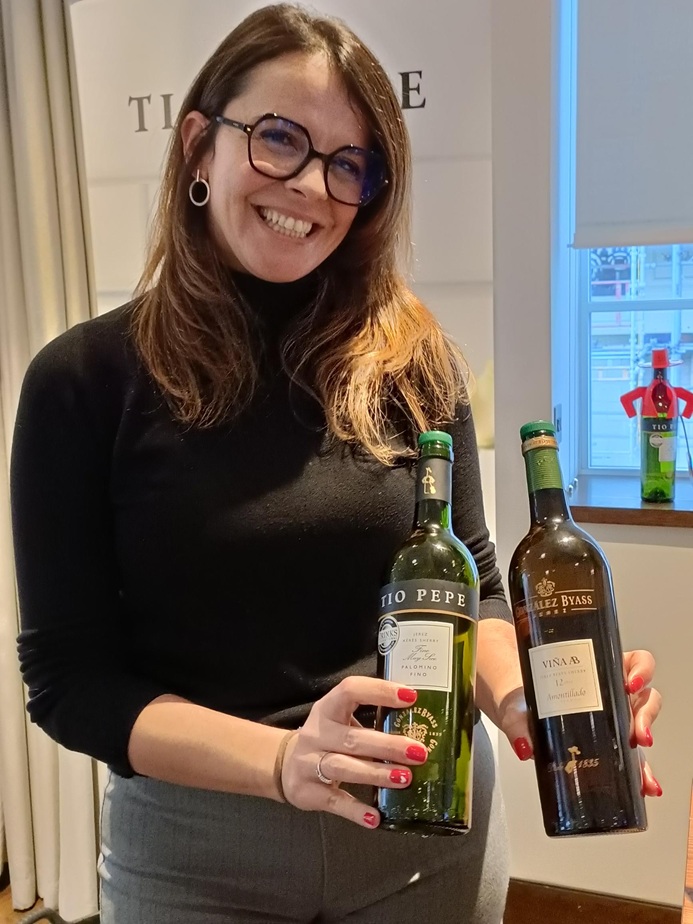
Silvia, who started working at González Byass in 2017 after working in hospitality and wine retail, expands: “Our primary ambition is to preserve and maintain the legacy of our wines, a responsibility passed down through generations (since the company was founded in 1835). I also aspire to make sherry more accessible to younger generations. It’s about simplifying the narrative, making the uniqueness of sherry understandable and enjoyable, especially in a fast-paced world. Complexity shouldn’t be intimidating. By presenting sherry in a simpler manner, recommending pairings, and emphasising quality for value, we hope to demystify sherry for newcomers. It’s about providing an opportunity to taste these unique wines without the barrier of complexity or high costs.
“I want the younger generation to see sherry as a unique and enriching experience. Beyond its complexity, sherry offers a journey into history, tradition, and the art of winemaking. It’s a treasure that requires time and care, and by embracing it, they can discover a world of flavours and stories.”
We have met up in London to take a moment to discuss one wine, to keep things simple given our tight schedules – but she shows up with two...
“Because I can’t decide (between them),” she explains. “If I choose this one (Viña AB Amontillado) because it’s my favourite, I have to bring this one (Tio Pepe Palomino Fino) because the amontillado is a development of the fino. They are related.”
She continues: “Tio Pepe is my wine. It’s been at my home since, I don’t know. And I choose Viña AB because it’s a perfect wine; it’s very complex and it came from Tio Pepe.”
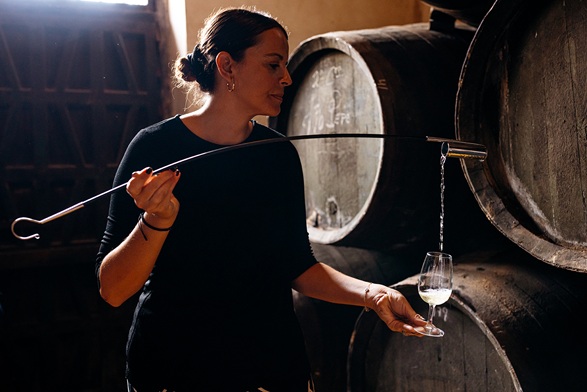
Amontillado is one of the most unique and revered types of sherry. It begins its life as fino sherry, undergoing a delicate process of biological ageing under the protective cover of flor (a yeast that forms a layer on top of the wine during the ageing process and protects it from oxygen). However, what sets amontillado apart is its oxidative ageing phase, which occurs after the flor layer is intentionally allowed to die off.
The ageing process of amontillado:
- First phase (biological ageing): The wine is initially aged under flor for several years. This process imparts delicate, fresh, and yeasty flavours while maintaining a crisp, light character.
- Second phase (oxidative ageing): Once the flor dies or is removed, the wine is exposed to oxygen, which results in a darker, richer wine with nutty, caramelised, and dried fruit flavours. The oxidation deepens the colour of the wine, turning it a rich amber or mahogany shade.
While amontillado undergoes both biological and oxidative aging, fino undergoes only biological ageing (under flor). Extended ageing under the flor imparts distinctive notes of bread, nuts, and sometimes green apple. The flor prevents oxidation, so the wine remains lighter, more refreshing, and less complex in flavour. It’s a style cherished for its crispness and purity.
Both of the selected wines are made from Palomino grapes – a high-acid grape that thrives in the unique terroir of the Jerez region in southern Spain, especially in the albariza soils rich in limestone.
Silvia uses the free-run and native yeasts for her top sherries. The only things added are a little sulphur during grape handling and grape spirit to fortify and stabilise the wine.
The wines
Viña AB Amontillado is a premium example of amontillado. Silvia employs traditional techniques alongside a meticulous process to craft this exceptional wine. After the initial biological ageing under flor, the wine is transferred to older American barrels where it undergoes oxidative ageing (the 600L barrels are only filled with 500L of wine), which allows it to develop the characteristic complexity of amontillado.Silvia ensures that the flor’s development is closely monitored, as the right balance between biological ageing and oxidative exposure is critical to producing a high-quality amontillado. The solera system helps maintain consistency across different vintages, ensuring that each bottle of Viña AB Amontillado is a refined expression of the region’s terroir and winemaking expertise.
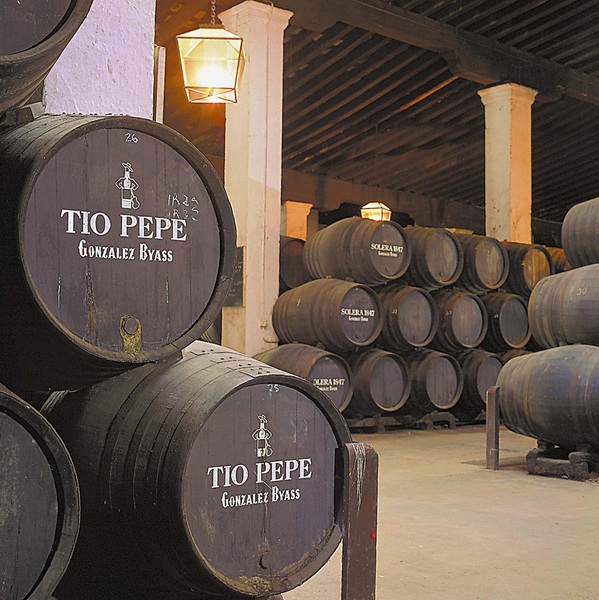
Tío Pepe is one of the most iconic fino sherries. Under the guidance of Silvia, this fino undergoes meticulous biological ageing under flor. Tío Pepe’s crispness, light body, and fresh acidity come from extended ageing in 600L American oak casks, where the flor remains active, protecting the wine from oxygen and giving it its signature yeasty, bready notes.
Silvia and the 12-strong winemaking team ensure that the flor remains healthy and vigorous, maintaining the characteristic freshness and delicate character that Tío Pepe is known for. The careful control of temperature and humidity during the ageing process is crucial for the success of fino sherry, as any imbalance can cause the flor to die prematurely, altering the wine’s profile.
Pouring the Tio Pepe, Silvia says: “It’s very special because it talks about my roots, my land, where I was born and this flor yeast that this wine needs to grow up, it only exists in the south of Spain. It’s very unique and different.”
Climate change
The impact of climate change on sherry production has been an area of concern for winemakers in the region. Rising temperatures, irregular rainfall patterns, and increasingly hot summers can significantly affect the growth of the flor, as well as the general viticulture of the region.The flor is highly sensitive to environmental factors. For it to thrive, the climate must be stable, with moderate temperatures and high humidity levels. Warmer winters and hotter summers can alter the conditions under which flor thrives, potentially leading to premature death or inadequate formation.
- Increased temperatures may reduce the amount of time the flor is able to remain viable during the ageing process, which can impact the quality and style of fino and amontillado sherries.
- Unpredictable rainfall can affect grape quality, reducing acidity or causing vine stress, which in turn impacts the flavour profile of the base wine.
Winemakers are adapting to these changes by:
- Managing the vineyard environment – using techniques like increasing canopy cover or selecting more heat-tolerant rootstocks to help mitigate the impact of high temperatures.
- Storing sherry in cooler cellars to help preserve the flor and slow oxidation.
So far, climate change hasn’t affected the humidity “because of the thick walls and the sand, but you have to monitor it more carefully,” Silvia explains. “To maintain this biological ageing system, it’s very challenging. You need to control everything, check every cask, because, as you know, the solera system is a blending system. And if you have a bad cask, you can contaminate all the vats. And this will be a very big problem in the winery.”
Despite these challenges, Silvia is still able to produce a wine that she says is perfect. I ask her: “Why is this Viña AB perfect?”
“For me, because it has all the good things from biological and oxidative ageing, but it’s more complex,” she replies.
During the long, lingering finish, I take a moment for myself to appreciate this style of wine. Its complexity. Its history. Its rich flavours. It’s perfection in a glass.

 English
English French
French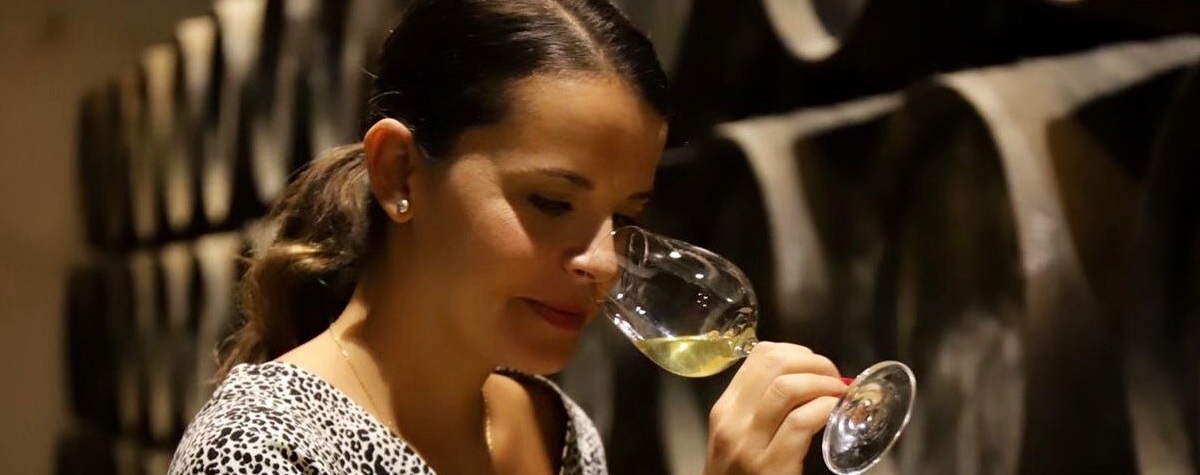

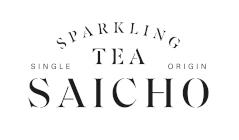





.png)


